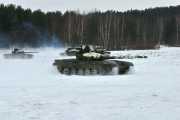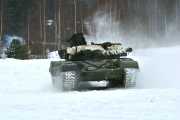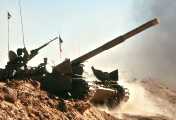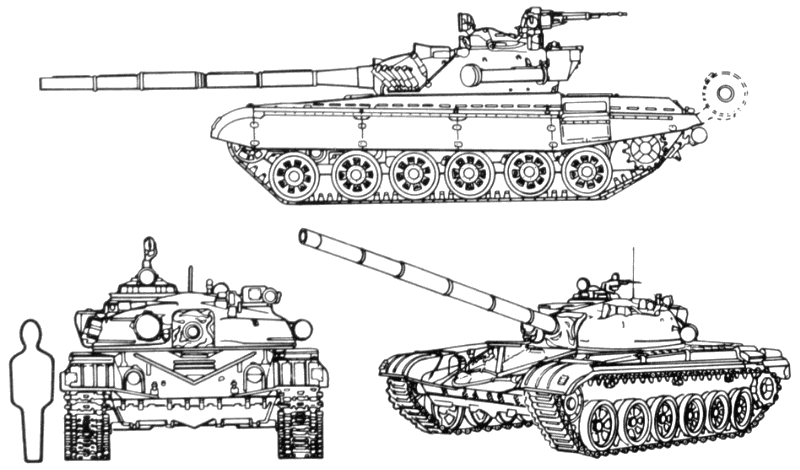The T-72's all-welded hull is divided into three main compartments with the driver at the front, fighting compartment in the center, and the engine and transmission at the rear.
The tank commander and gunner sit in the turret with the commander on the right and the gunner on the left.
The turrets of older former Soviet Union tanks rotate much slower than those on US and NATO tanks.
It takes more than 21 seconds for T-70-series tank turrets to rotate through a full 360°.
The T-90-series tank turrets can rotate a full 360° in just 6 seconds, which is as fast as the US M1 Abrams and M2 BFV.

Recognition features:
- Six large evenly-spaced road wheels on each side with the drive sprocket at the rear, idler at the front and three return rollers.
- Two optional drum-type fuel tanks that can be fitted to the vehicle for an increased operational range.
- An unditching beam carried at the rear.
- A snorkel for deep fording that is carried on the left side of the turret to the rear.
- A commander's cupola with a periscope and an infrared searchlight on each side.
- A gunner's hatch mounted with two observation periscopes. An infrared searchlight is mounted in front and to the left of this hatch along with a laser rangefinder.
- Another infrared searchlight mounted on the right side of the main armament.
- A single loader's hatch to the right of the turret with a periscope that can operate to the front or rear.
- A driver's single hatch cover, in front of which is a wide-angle observation periscope.
- Two light-steel stowage boxes mounted on the turret, one at the rear and the other on the right.
- Integrated fuel, oil and storage containers along each side of the hull that give the fenders a streamlined shape.
- An oil cell and stowage boxes on the top left side of the hull.
- Four removable armored skirt plates fitted over the forward part of the track for additional protection.
- A dozer blade mounted under the nose.
- A searchlight and infrared headlamp mounted to the rear of the deflector, on the right side.
- Turret rails.
- A box-like radiation detector/actuator mounted on the right side of the turret behind the compressed air tanks.
- A blower mounted at the rear of the turret.
- A sharply-sloped glacis made of a new laminate armor 200mm thick and a V-shaped water and debris deflector mounted to the glacis plate.

Since the Soviet-built T-72 entered production, many improvements have been made to the vehicle, making it difficult to distinguish individual versions of the tank.
Improvements include: Increased protection, better mobility, and enhanced firepower.
Note that some countries have inventories of T-72, T-72M, and T-72M1 with different versions of each variant. Also, many
variants were upgraded or modified. Some T-72M1s do not have smoke grenade launchers or track skirts. Some T-72s/T-72Ms have
smoke grenade launchers. More reliable discriminators are armor and rangefinder/FCS.
A variety of thermal sights are available. They include the Russian Agava-2, French SAGEM-produced ALIS and Namut sight from Peleng.
Optional mine-clearing equipment is available.
- T-72
- Original production model. Recognition features:
- Fully tracked.
- Six large die-cast, evenly spaced road wheels with three support rollers.
- Sharply sloped upper glacis with V-shaped splash guard.
- Rounded turret mounted midway on tank.
- Single snorkel mounted on left side of turet.
- Engine exhaust on top of back deck.
- Bore evacuator 1/3 way from muzzle.
- Infrared light to right of main gun.
- New design turret machine gun; no provision for firing from within tank.
- Integrated fuel cells and storage containers, giving streamlined appearance to fenders.
- T-72M
- Original Polish and former-Czechoslovakian T-72-series tank from which Polish/Czechoslovakian T-72M1 was derived.
T-72M differs from T-72 in replacing the right-side coincident rangefinder with a centerline-mounted TPDK-1 LRF.
- T-72A
- An improved version of the basic T-72.
Overall, its offensive capabilities are similar to the basic T-72, but it is much better protected.
The Russian variant differs from T-72 with the TPDK-1 LRF, added track skirts, additional armor on the turret front and top, provisions for mounting reactive armor, smoke grenade launchers, internal changes, and a slight weight increase.
Version with Kontact ERA is known as T-72AV.
The Russian export version and Polish/Czechoslovakian counterparts are called T-72M1. See data above.
Version with Kontact ERA is known as T-72M1V.

T-72M1
Finnish Defence Forces Photo
800x533, 100K, JPEG

T-72M1
Finnish Defence Forces Photo
800x533, 148K, JPEG

T-72M1
Finnish Defence Forces Photo
800x533, 102K, JPEG

T-72M1
Finnish Defence Forces Photo
800x533, 99K, JPEG

T-72M1
Finnish Defence Forces Photo
800x533, 75K, JPEG

T-72M1
Finnish Defence Forces Photo
800x533, 83K, JPEG

T-72M1
Finnish Defence Forces Photo
800x533, 80K, JPEG

T-72M1
Finnish Defence Forces Photo
800x533, 79K, JPEG

T-72M1
Exercise - Lumimyrsky 03
Finnish Defence Forces Photo
640x480, 60K, JPEG

T-72M1
Exercise - Aalto 2004
Finnish Defence Forces Photo
800x600, 173K, JPEG

T-72M1
Exercise - Aalto 2004
Finnish Defence Forces Photo
1115x825, 271K, JPEG

T-72M1
Exercise - Aalto 2004
Finnish Defence Forces Photo
1300x955, 376K, JPEG
- T-72AK/T-72M1K
- Commander's variant with additional radios.
- T-72AM/Banan
- Ukrainian T-72A upgrade with ERA, a new engine, and additional smoke grenade launchers.
The T-72AG upgrade has a 1200-hp engine, Shtora-1 ATGM jammer, and 1G46 (T-80U) FCS with thermal night sights.
- T-72B
-
See data above. The T-72B is the second main variant from the original Russian T-72 tank (after T-72A).
The T-72B's 1K13-49 sight is both night sight and ATGM launch sight. However, it cannot be used for both functions simultaneously.
Thermal gunner night sights are available which permit night launch of ATGMs.

- T-72B1
- Variant introduced in 1986 without ATGM launch capability.
- T-72BK
- Commander's variant with additional radios.
- T-72BM
- Version with Kontakt-5 explosive reactive armor. This system is being fielded and is available for export.
- T-72M1M
- T-72M1 variant upgraded to T-72B standard.
- T-72M2/Moderna
- Slovakian T-72M upgrade with new engine and fire control, SFIM thermal sight,
laser warning receiver, ERA, and 2 x 20mm AA guns on turret
- T-72M4CZ
- Czech variant with TURMS FCS with thermal sight, new engine, increased protection ERA, and 48t weight.
T-72M3CZ is a less radical upgrade - for instance the existing engine is modified.
- T-72MP
- Ukrainian upgrade with a 1,000-hp engine, added armor, Shtora-1, and SAGEM FCS and thermal sights.
- M-84
-
1984. Serbian (former Yugoslavia) tank upgraded to T-72M1 standard, but with indigenous sights.
With an upgraded V-46-6TK 985 hp (735 kW) engine, the tank is M-84A.
With a new SUV-M-84 computerised fire-control system, gyrocompass, communication, and intercom systems the tank is M-84AB.
The M-84 ABI armored recovery vehicle variant is fitted with specialised recovery equipment.
A Croatian improved version of M-84 is M-84A4/Sniper, with improved fire control and thermal night sights.
A Slovenian upgrade uses the state-of-the-art and the well-marketed EFCS-3 FCS.

Serbian M-84.
Serbian Land Forces Photo
1024x768, 117K, JPEG

Serbian M-84.
Serbian Land Forces Photo
1024x768, 96K, JPEG

Serbian M-84.
Serbian Land Forces Photo
1024x683, 238K, JPEG

Serbian M-84.
Serbian Land Forces Photo
1024x831, 367K, JPEG

Serbian M-84.
Serbian Land Forces Photo
1024x678, 210K, JPEG

Kuwaiti M-84 lays a smoke screen.
15-MAR-1992
U.S. DoD Photo
1280x768, 300K, JPEG

Kuwaiti M-84.
15-MAY-1992
U.S. DoD Photo
1280x872, 251K, JPEG

Serbian M-84 ABI ARV.
Serbian Land Forces Photo
1024x768, 94K, JPEG
- T-72S/Shilden
- Russian export T-72A upgraded to be comparable to the T-72BM standard. Although similar to the T-72BM,
it may have less turret front protection. The early T-72S tank has Kontakt ERA.
- PT-91/Twardy
- Polish upgrade of the T-72M1 tank with ERA, laser warning receiver, smoke grenade launchers, and Tiger fire control system. Sights include a thermal gunner night sight.

PT-91
Polish Land Forces Photo
640x480, 91K, JPEG
- T-90
- Successor to T-72BM. This tank has been tentatively approved for production and adoption as a
standard tank, alongside the T-80U, for the Russian army. The T-90 uses the gun and 1G46 gunner sights from T-80U, a new engine,
and thermal sights. Protective measures include Kontakt-5 ERA, laser warning receivers, and the SHTORA infrared ATGM jamming system.
- BREM-1 Armored Recovery/Repair Vehicle (ARRV)
- This ARRV is equipped with a hydraulic crane, capable of lifting 12 tons, mounted at the front of the hull on the left side.
Other equipment includes a main winch with a capacity of 25 tons that can be increased to 100 tons, an auxiliary winch, a hydraulically operated dozer/stabilizing blade at the front of the hull, towing equipment, and a complete range of tools and recovery equipment.
This vehicle is known to have been used in East Germany.
- IMR-2 Combat Engineer Vehicle
- The IMR-2 is believed to be the replacement for the T-55 IMR.
A crane is mounted that can be fitted with a number of attachments including pincers for uprooting trees.
At the front of the vehicle is a dozer blade that can be used in a straight or V-configuration.

Refurbished T-72 tanks and BMP-1 IFVs
Iraqi 9th Division (Mechanized)
Taji, Iraq
17-NOV-2005
NATO Photo by Major Borkur Gunnarson
1024x768, 252K, JPEG

Refurbished T-72 tanks and BMP-1 IFVs
Iraqi 9th Division (Mechanized)
Taji, Iraq
17-NOV-2005
NATO Photo by Major Borkur Gunnarson
1024x768, 245K, JPEG

 Recognition features:
Recognition features:

